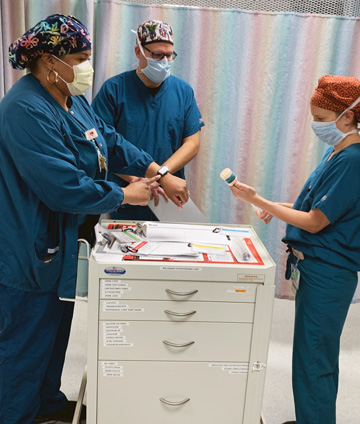MH is clearly a rare event, but that doesn’t mean you should hesitate to call the hotline if your intuition is telling you a patient could be in trouble. Always err on the side of caution — the consultants are available to help and
welcome the opportunity. “One of the biggest mistakes facilities make is not believing the patient could be experiencing a true MH event.” says Dr. Fremming. “MH is uncommon, but it does happen and when it does, time is of
the essence.”
The most difficult part of the job for MHAUS consultants is assessing the clinical facts of cases that aren’t so straightforward. “MH is a diagnosis of exclusion,” says Dr. Fremming. “The initial signs and symptoms are
generally the same as other potential complications.”
With response time playing a critical role in the event of a true MH emergency and its eventual outcome, Dr. Fremming stresses the importance of proper and realistic training. “Facilities need to conduct routine drills of response protocols,”
he says. “Because you’re dealing with an uncommon event, it’s easy for staff to forget steps they haven’t practiced in a realistic setting.” In addition to in-house education, MHAUS conducts mock drills that facilities
can schedule based on availability.
Routine MH training should be conducted every six months or at least on an annual basis, according to Robert Simon, DNP, MS, CRNA, CHSE, CNE, chief CRNA at Huntington Valley (Pa.) Anesthesia Associates and assistant program director at Frank J
Tornetta School of Anesthesia at Einstein Medical Center Montgomery in Norristown, Pa. He also encourages facilities to lean heavily on anesthesia providers to participate in or even conduct the training sessions.
“MH is an emergency that primarily occurs after use of an anesthetic triggering agent, be that succinylcholine, sevoflurane, desflurane or isoflurane,” he says. “These medications are actively administered by anesthesia professionals
across the country.”
Anesthesia providers are also responsible for monitoring the patient’s vital signs and remaining vigilant to identify and manage potential complications. Dr. Simon believes they must communicate the onset of MH symptoms to the surgeon and
the OR team and guide the treatment protocols. “This is why it’s important for anesthesia providers to be involved in MH drills and help prepare the OR team for a real-life event,” he says.
Part of Dr. Simon’s training focuses on helping OR staff recognize the signs and symptoms of patients who might be experiencing MH. “You need to make sure everyone on the care team knows the potential risk factors,” he says.
To help staff recognize signs of trouble, Dr. Simon created and distributed several easy-to-remember staff handouts based on material pulled from MHAUS’s informative website. One of the handouts included information about what to look for
in patients who might be experiencing MH, including an unexplained and sudden rise in end-tidal CO2 (greater than 55mmHg); decreased SaO2; unexplained tachycardia or arrhythmias; tachypnea; labile blood pressure; masseter muscle or generalized
muscle rigidity; rising body temperature; and mottled, cyanotic skin.
In addition to training that simulates the step-by-step moves staff must take during a real-life event, make sure your facility is properly equipped to react to and mitigate an MH emergency. “Your surgical team must have immediate access
to a fully stocked MH cart, and you should start instituting therapy as soon as you suspect it’s a likely MH event,” says Dr. Fremming. “All outpatient surgery centers should have the supplies they need to begin treatment
within 10 minutes.”
Conduct regular audits to ensure the supplies on an MH cart are fully stocked and current. (Check here for a comprehensive list of suggested
supplies.) Store the cart where it’s easily accessible to staff and make sure every member of the care team knows where it’s kept.
Regardless of how well your staff is prepared to manage an MH emergency, provide them with visual aids and practical tools to help guide their efforts if they freeze in the moment or lose track of what steps they need to take. Dr. Simon suggests
that leaders preempt any type of procedural paralysis by papering the clinical areas with documents staff can look to for help. “Post the MHAUS hotline number on the MH cart and in every OR, the PACU and procedure rooms where triggering
agents are administered,” he says.
Role responsibility cards, which provide individual staff members with a concise list of tasks they need to accomplish during an MH emergency and serve as quick-reference guides, keep the team focused on what they need to do during the critical
stages of the response effort. The cards can be clipped to a staff member’s identification badge or passed out as responders arrive at the patient’s bedside to help.
Finally, it’s worth reiterating what is perhaps the most crucial piece of advice regarding MH emergencies: Whenever you’re in doubt, just make the call. “If you have any suspicion of MH, reach out to us on the hotline,”
says Dr. Fremming. “The earlier the treatment, the better the prognosis.” OSM
.svg?sfvrsn=be606e78_3)

.svg?sfvrsn=56b2f850_5)